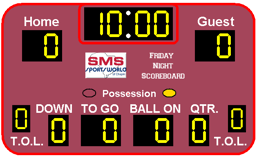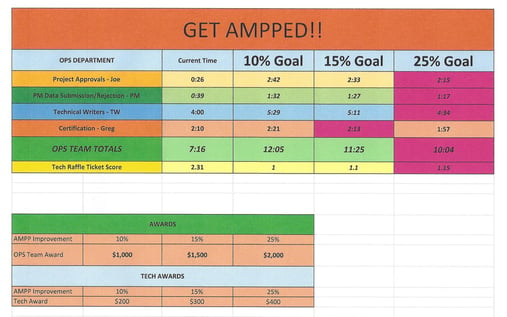 You’re at football game. What do you want to know? You may wish to know, who’s playing? Who’s on the team? What color uniform is the team you’re rooting for wearing? If your child is playing, you want to know what number he’s wearing.
You’re at football game. What do you want to know? You may wish to know, who’s playing? Who’s on the team? What color uniform is the team you’re rooting for wearing? If your child is playing, you want to know what number he’s wearing.
Most importantly you want to know the score.
You’d look to the scoreboard, and voila! You instantly know who’s winning.
Mini-Games 3 Second Rule
I used to officiate basketball games, but this 3 second rule is nothing to do with how long a player stays inside the free throw lanes.
The three second rule in Mini-Games requires you to quickly state the score in just three seconds. If it takes more than three seconds to determine if you’re winning or losing, you don’t have an effective Mini-Game scoreboard, and most likely you don’t have an effective mini-game.
 Look at the scoreboard from the video we shared last blog WHAT’S A MINI-GAME? It’s pretty clear how well the team is doing to get Andy a tattoo on the stern of the USS Bernard.
Look at the scoreboard from the video we shared last blog WHAT’S A MINI-GAME? It’s pretty clear how well the team is doing to get Andy a tattoo on the stern of the USS Bernard.
All the elements of building a good Mini-Game are important, however once the game is started, nothing is more important than ensuring everyone on your team can easily see how they are doing. Line of Sight is what Great Game calls this. We need to have our people see how their efforts are doing to generate the outcomes the company needs, and for which they will be rewarded.
.jpg?width=257&name=MiniGame%20Fishing%20for%20Clients%20Scoreboard%20(Empty).jpg) Look at this scorecard for a company working on attracting more new customers. Pretty easy to see they’re winning the game, isn’t it?
Look at this scorecard for a company working on attracting more new customers. Pretty easy to see they’re winning the game, isn’t it?
Let’s review the Mini-Game Design Steps to help you create your Successful Mini-Game:
- Name the Game – What’s the Improvement Objective?
- Set the Goal
- Estimate the Benefit
- Identify the players
- Determine the timeframe
- Develop a theme and build a scoreboard
.jpg?width=257&name=MiniGame%20Fishing%20for%20Clients%20Scoreboard%20(Full).jpg)
- Decide on the reward
- Establish a Huddle Rhythm
- Play the Game
- Celebrate the Win
The argument could be made that the scoreboard is so critical it should be given a separate number.
Mini-Game instead of a Suggestion Box
Is it just me, or does it seem the Suggestion Box has gone the way of the Dodo bird? Seldom do I see a suggestion box in an office today, and more seldom do I see it being used effectively act to improve the business. (Please if you have an effective suggestion box in your business, comment on this blog!)
Great Game of Business suggests using the Mini-Game platform as a “new and improved” Suggestion Box.
Here are a few of their recommendations:
- Ask for suggestions on a specific problem or issue. (The quality and relevancy of ideas will go up.)
- Require the employee to make a business case for each suggestion. (Real, Win, Worth)
- Require the employee to get at least two supporters of the suggestion and their signoff. (Helps to filter out personal issues)
- Require a commitment to help implement the suggestion. (Establishes ownership upfront)
- Use a Mini-Game to execute on the idea.
If you have a suggestion box, you’re going to get a lot less suggestions using this methodology/policy. Do you want quality or quantity? Suggestions boxes can be filled often with complaints and no intention to provide action and direction.
One of my customers did a theme for a trimester asking for ideas to save money in the business. The theme was “Shark Tank” with the best idea receiving a substantial cash prize. Staff could organize into teams. It took adding additional time for the staff submit ideas (see Employee Feedback and Closing the Loop) to the theme. One individual presented an idea to save the company over $30K annually.
As the Employee Feedback blog suggests, getting ideas isn’t difficult. Creating a culture that submits constructive ideas which are then acted upon by management requires a rigorous set of disciplines and initiative too often lacking in our “Whirlwind” centered business.
Mini Game Example
 One of my customers Independent Floor Testing and Inspection wanted to improve their operations segment of the business, shortening time to deliver on several activities. The goal was to improve performance by 10, 15 or 25 percent. The team goals in terms of reward are shown in the box below their scoreboard. There is an internal team (Ops Department) and an external team (Techs). The latter is critical to the success, as independent contractors, their measure is the only metric needing increase. The rest of the metrics goal were to decreasing time.
One of my customers Independent Floor Testing and Inspection wanted to improve their operations segment of the business, shortening time to deliver on several activities. The goal was to improve performance by 10, 15 or 25 percent. The team goals in terms of reward are shown in the box below their scoreboard. There is an internal team (Ops Department) and an external team (Techs). The latter is critical to the success, as independent contractors, their measure is the only metric needing increase. The rest of the metrics goal were to decreasing time.
.jpg?width=507&height=279&name=AMPPED%20MiniGame%20Baseling%20Measures%20(IFTI).jpg) To understand the achievement, you need to view the Baseline Measures conducted prior to the start of the Mini-Game. See chart.
To understand the achievement, you need to view the Baseline Measures conducted prior to the start of the Mini-Game. See chart.
The scoreboard here depicts the success they are achieving with one week to go in the Mini-Game. The game closed last Friday, and while I don’t have the final results, the leader indicated they were going to blow well past the 25% improvement in every category.
The Actual in the first column of the chart is difficult to understand at first glance, because in comparison to the 10, 15 and 25% measurements in almost every case the results are significantly better than the 25% improvement mark.
While this scoreboard fails to meet the 3 second rule for me, it achieved the desired result and then some for my customer. The 10, 15, and 25 percent goals and their corresponding metrics were established based on the baselines.
Is your business looking to increase short-term as well as long term results? If you’re a small to midsize business owner/CEO with a ravenous appetite to improve his or her leadership skills and business results, contact dwick@positioningsystems.com.
Next Blog – Determining Counterbalances
One of the more difficult challenges after my customers determine their One Thing for the year or quarter is setting up a Counter Balance. We’ll discuss what a Counter Balance is, why it is critical to determine and some rules around establishing it next blog.






.jpeg?width=150&height=135&name=Hand%20with%20marker%20writing%20the%20question%20Whats%20Next_%20(1).jpeg)

